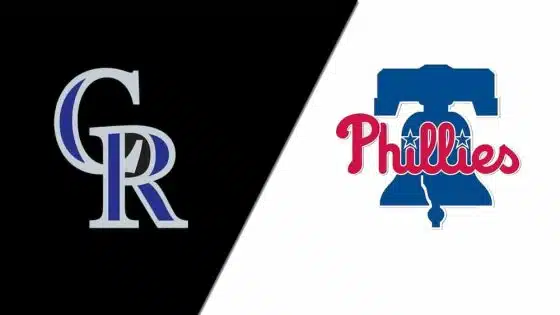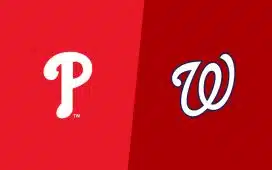My first thought upon seeing the newly acquired Brad Miller in a Phillies uniform yesterday was, Jeez, what a terrible number they’ve stuck him with. When Craig Kimbrel signed with the Cubs a couple of weeks ago, he chose to wear #24 because, he said, “it looked like an athletic number.” Maybe. It’s hard to argue with any number worn by both Willie Mays and Ken Griffey, Jr. Still, I’d wager that even they would look just a tiny bit less athletic had they been cursed with Miller’s new number, 33.
33 is, in my mind, the absolute worst of all the traditional baseball uniform numbers doled out by club equipment managers. (I’m not even going to address the oddball numbers such as Pat Neshek’s 93 or Adam Ottavino’s 00, or any number above 54 because all of them are just plain stupid and are selected, I’m convinced, precisely because they make no aesthetic sense on a baseball diamond. If your goal is to look like a fool on the field I’m not going to call you out for achieving it. The most I’ll say is, “Mission accomplished, big guy.”)
My in-depth analysis of the history of #33 (conducted solely through a search of Baseball Reference during a lazy Father’s Day afternoon) reveals that while there has been no shortage of Phillies who have worn the number through the years, few shone while adorning it. Most were anonymous figures who drifted silently in and out of the game. Of the better players saddled with it, most switched as soon as they had the clout to do so while the rest found themselves stuck with it, most likely against their will, because they were on the downsides of their careers and knew better than to create friction over their assigned number. These were guys one step from the unemployment line who understood that any number, even one as horrific as 33, was better than no number at all.
In all, 51 different players wore #33 for at least one game with the Phillies, making it the fifth most-issued number in Phillies history (#34, worn by 64 players, was tops). Yet while such Phillies luminaries as Roy Halladay, Cliff Lee, Kevin “no-hit” Millwood and Gary Matthews all wore #34, only Aaron Rowand stands out in my mind as someone who might be said to have been proud to don #33.
True, Lee also wore #33 but that comes with an asterisk – he lost his preferred #34 to Halladay when he departed after the 2009 season and got stuck with #33 upon his return in 2011. To me he never looked right wearing #33; something was just a bit off. Still, if nothing else, Lee is perhaps the best pitcher with the worst number in Phillies history.
Growing up in the ‘70s, Wayne Twitchell was the #33 I remembered here and, unlike Lee, the number fit everything I knew about Twitchell. “Twitch” was a gangly pitcher who never seemed to fulfill his promise; he was all arms and legs, swinging wildly beneath a hangdog visage that at no time engendered confidence whenever he took the mound during his tenure in pinstripes, from 1971-77. Oh well, I remember thinking, at least we’ve got Carlton — #32 – tomorrow.
Two Mike Jacksons wore the number – one in 1986-87, the other in 1970. Neither were memorable. Andy Tracy wore it, as did Jose Offerman, Drew Hutchison, Ricky Ledee and Chad Ogea, among others. All were forgettable. Ruben Amaro, Jr. wore it, too, and don’t you wish you could forget him.
There were some notable players who wore it but most likely not because they wanted to. Case in point: Willie Montanez, who wore it when he was a September call-up in 1970. Mike Jackson the First had been sent down to the minors a few months earlier and the uniform was no doubt lying around, within easy reach to unload on a minor leaguer lacking the authority to push back. Jackson and Montanez were roughly the same size and, this being the era before uniforms came with nameplates sewn on the back, it didn’t take much to transform Jackson’s old uni into Montanez’s new one. Just a trip through the wash cycle would do the trick. When Montanez showed up on Opening Day 1971 as the hotshot Rookie-of-the-Year candidate, though, he was wearing #27.
Further back, Granny Hamner wore #33 as a teenager who didn’t play all that much with the Phils of the mid-to-late 1940s. After he finally cracked the regular lineup in 1948, however, he switched to #2, which he would wear for both the pennant-winning Whiz Kids of 1950 and steadily descending Was Kids of the rest of the decade. More recently, Pat Burrell debuted in 2000 wearing #33. The following year he thought better of it and showed up wearing #5.
One of the more interesting 33’s in Phillies history was Bo Belinsky, who wore it during the 1965-66 seasons. Belinsky was known for two things during his career – throwing the first no-hitter in Los Angeles Angels history (in 1962), and allegedly bedding Ginger from Gilligan’s Island, along with Mamie Van Doren, Ann Margaret, Connie Stevens and other starlets, including the 1965 Playboy Playmate of the Year, in the aftermath. He’d wind up with a 28-51 record and several notches on his bedpost; he was probably too distracted to ask for a different number.
Rheal Cormier wore the number for a season, as did Scott Ruffcorn. Fernando Valenzuela wore it during his eight appearances in pinstripes in 1994 and both Gene and Greg Harris wore it, too. If you remember either of the Harrises, go to the front of the room. Dan Warthen wore it, as did Wally Flager, Roy Bruner and the immortal Prince Oana, who wore it first, in 1934, for all 26 of his at-bats that season.
What I’m trying to say, I guess, is this: welcome to Philly, Brad Miller. We’re all pulling for you. But you might want to keep a bag packed.





